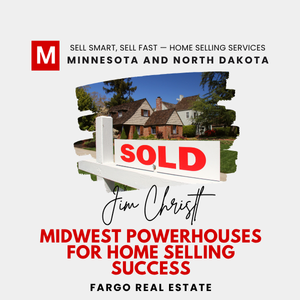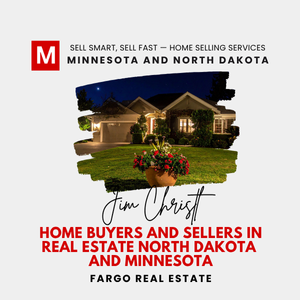
Local Snapshot: Minnesota and North Dakota real estate markets show how small investors are shifting the balance between renting and owning across the Upper Midwest.
North Dakota and Minnesota Real Estate: How Small Investors Are Creating Communities of Renters
Written by Jim Christl and Shannon Barnum, Modern Market REALTORS®
About the authors: Jim Christl and Shannon Barnum are experienced professionals in the North Dakota real estate and Minnesota real estate markets. They help home buyers, sellers, and small investors navigate competitive conditions in Fargo, Moorhead, West Fargo, Horace, and surrounding communities.
Table of Contents
Introduction
For decades, homeownership has been the cornerstone of the American dream — a symbol of stability, equity-building, and generational wealth. But as homeownership rates continue to decline, particularly among younger buyers, new forces are stepping in to fill the void. Across the U.S., and increasingly in smaller markets like North Dakota and Minnesota, small investors are buying up single-family homes and turning them into rentals.
Unlike Wall Street–backed institutional investors that tend to focus on Sun Belt metros, these small investors are targeting affordable Midwest markets where families still dream of owning. Their strategy: create neighborhoods of renters where ownership is increasingly out of reach. For residents of Fargo, Moorhead, Grand Forks, and smaller Minnesota towns, the trend poses a pressing question: is the American dream shifting from owning to renting?
The Decline of American Homeownership
What the Numbers Say
Homeownership in the U.S. peaked around 69% in 2004. Today, it hovers near 65% nationally. That drop may not sound dramatic, but in real terms it represents millions of households who rent instead of own. And the Midwest, long considered the “last affordable frontier,” is not immune.
- Rising mortgage rates have locked out first-time buyers.
- Low inventory keeps prices high.
- Student debt and stagnant wages leave younger buyers unable to save for down payments.
Local Snapshot — Minnesota and North Dakota
In Minnesota, homeownership is about 72% — above the national average, but slipping as prices rise in the Twin Cities and ripple into surrounding communities.
In North Dakota, the oil boom once boosted ownership, but today housing costs in Fargo and Bismarck are catching up to incomes.
Both states share a troubling pattern: renters are growing in number faster than homeowners, and single-family rental homes — not just apartments — are driving that shift.
Small Investors Step In
Who Are the New Landlords?
While Wall Street–funded giants like Invitation Homes dominate headlines in Phoenix or Atlanta, in the Upper Midwest it’s “mom-and-pop” investors, often with portfolios of 5–50 homes, reshaping the market.
- Retirees diversifying savings into real estate.
- Local contractors buying and flipping into rentals.
- Young entrepreneurs leveraging FHA or VA loans, then pivoting to rentals.
Strategy Behind the Shift
Investors recognize that families who can’t buy still crave space, schools, and stability. So they buy the exact homes those families might have purchased — three-bedroom ramblers in Fargo, split-levels in Moorhead, starter homes in Grand Forks — and lease them back.
Communities of Renters
Some investors now actively market “neighborhood rental living” — entire cul-de-sacs or developments filled with renters, managed professionally. It offers community feel without ownership. For tenants, it’s a solution. For would-be buyers, it’s competition.
Impact on Families and Communities
The New Barrier to Ownership
Every home purchased by a small investor is one less entry-level home available to a first-time buyer. In low-supply markets like Fargo-Moorhead, this can push buyers into bidding wars — or out of the market entirely.
Rising Prices and Scarcity
- Homes under $300,000 in Moorhead now sell in days, often with multiple offers.
- Investors paying cash or waiving inspections outcompete FHA- and VA-backed buyers.
- Result: a cycle where prices rise faster than wages.
Generational Divide
- Millennials and Gen Z face renting as their only viable option.
- Boomers and Gen X — many already owning homes — benefit from appreciation and rental income.
This divide could reshape wealth distribution for decades.
Why the Midwest Matters
From Affordable Refuge to Investor Target
North Dakota and Minnesota were long safe havens for affordability. But affordability attracts investors. Compared to California or New York, where entry prices are sky-high, a $200,000 Moorhead home looks like a bargain investment.
Regional Trends
- Fargo, ND: Median home price near $300,000; rental demand outpacing new construction.
- Moorhead, MN: Twin homes and patio homes increasingly marketed to investors.
- Grand Forks, ND: University population ensures steady rental demand.
- Rural MN towns: Investors bet on remote work and lifestyle migration trends.
The Long-Term Question
If small investors own too much of the entry-level housing stock, does the region risk losing its affordability edge?
The Flip Side: Opportunities in Renting
Stability for Tenants
While critics focus on ownership loss, small investors argue they provide solutions:
- Families priced out of buying still get single-family homes.
- Professional management reduces maintenance headaches.
- Renters can test neighborhoods before buying.
Building New Communities
Some investors intentionally design rental-only neighborhoods with shared amenities, walking trails, or playgrounds — a hybrid of suburban subdivision and apartment complex.
Mobility and Flexibility
For a workforce increasingly mobile, renting offers flexibility. And in regions where jobs depend on energy booms or agricultural cycles, flexibility can be a financial advantage.
What’s Next for Minnesota and North Dakota Housing?
Predictions for the Next Decade
- More hybrid neighborhoods: A mix of owners and renters in developments once designed exclusively for buyers.
- Policy debates: Local governments may weigh caps on investor-owned homes or offer first-time buyer incentives.
- Wealth gap widening: If ownership continues to slip, renters will lose out on decades of potential equity.
- Community identity shift: Will Fargo and Moorhead become renter-centric, or preserve their owner-driven roots?
Local Voices Matter
Agents, policymakers, and residents will shape whether small investor growth strengthens or weakens community fabric.
FAQ: The Future of Homeownership in Minnesota & North Dakota
What’s driving the decline in homeownership?
Multiple forces are converging: rising interest rates, stagnant wages, student debt, and scarce inventory. In Fargo-Moorhead, homes under $300,000 are especially competitive, making it harder for first-time buyers to secure a property.
Are small investors worse than institutional ones?
Not necessarily. Small investors often live locally and manage homes personally. But when their presence grows in aggregate, the effect mirrors institutional buyers: shrinking inventory and higher competition for regular buyers.
How does this impact renters?
For renters, it can be positive — more access to well-maintained single-family homes, better management, and neighborhood living. The downside is higher rent costs as investors pass on acquisition expenses.
Will homeownership rebound?
Experts believe homeownership could stabilize if interest rates ease and new construction accelerates. However, with demand outpacing supply, the rebound may be muted in North Dakota and Minnesota.
Are policies being discussed?
Yes. Some states are considering restrictions on investor ownership or offering tax credits for first-time buyers. In the Midwest, most efforts focus on encouraging new construction rather than limiting investor activity.
Can renting ever replace owning as the “dream”?
Renting offers flexibility but not long-term equity. For many families, renting is a stopgap, not the goal. Without ownership, generational wealth gaps could widen, especially in affordable regions like the Upper Midwest.
What advice do REALTORS® give?
Local agents stress preparation: get pre-approved, act quickly, and be ready for bidding wars. They also note the importance of looking at twin homes, patio homes, or less “traditional” options that investors may overlook.
Should first-time buyers be worried?
Worried, no. Prepared, yes. Buyers in Fargo, Moorhead, and Grand Forks still have opportunities, but speed and strategy matter more than ever. Partnering with experienced local REALTORS® is key.
What advice should home buyers in North Dakota and Minnesota follow?
Home buyers in the North Dakota real estate and Minnesota real estate markets should:
- Get pre-approved early — it shows sellers you’re serious and helps you compete with cash buyers.
- Be flexible on property type — consider twin homes, patio homes, or condos, which investors may overlook.
- Work with local REALTORS® — they can alert you to new listings before investors move in.
- Act quickly — in Fargo and Moorhead, desirable homes often sell within 48 hours.
- Look beyond the metro — emerging towns like Dilworth, Glyndon, and Casselton in Minnesota or Lisbon, Valley City, and Jamestown in North Dakota may offer better affordability.
- Stay protected in bidding wars — shorten inspection periods instead of waiving them entirely.
- Think long-term — even a starter home builds equity and stability that renting cannot.
The New American Dream of Renting Homes — how small investors are reshaping North Dakota real estate and Minnesota real estate, explained by Modern Market REALTORS®.
Fargo-Moorhead: The Real Estate Goldmine You Didn’t Know About
✅ Live Where You Love — whether you’re renting or buying, Minnesota and North Dakota housing markets are evolving fast. The question for the next decade isn’t just about affordability; it’s about whether the American dream adapts to new realities or risks leaving families behind.
Real Estate Home Services – Fargo–Moorhead Area
Buy • Sell • Relocate • New Developments
Serving Fargo, Moorhead, West Fargo, Horace, Kindred, Mapleton (ND) and Glyndon (MN). Start with our all-in-one hub:
👉 Real Estate Home Services Hub
- Fargo–Moorhead Home Selling Services
– Pricing strategy, prep, marketing, and negotiation for higher net.
🔗 Seller Resources & Checklists - Home Buying Services in Fargo–Moorhead
– Tours, offer strategy, inspections, and closing guidance.
🔗 Buyer Resources & Guides - Relocation Services to Fargo–Moorhead (ND & MN)
– Neighborhood matchmaking, timing your move, schools & commute help.
📦 Moving Checklist - Fargo–Moorhead Communities & Market Trends
– Neighborhood guides, pricing, inventory, and local insights.
🏗️ New Home Developments (Fargo Area) - Luxury Home Selling Service – Fargo–Moorhead
– Discreet, high-impact marketing for premium properties. - Transparent Pricing Promise (No Hidden Fees)
– Clear commissions and services—no surprises.
Coverage: Fargo • Moorhead • West Fargo • Horace • Kindred • Mapleton • Glyndon
Why Minnesota and North Dakota Are Prime Markets for Single Family Homes Investment



